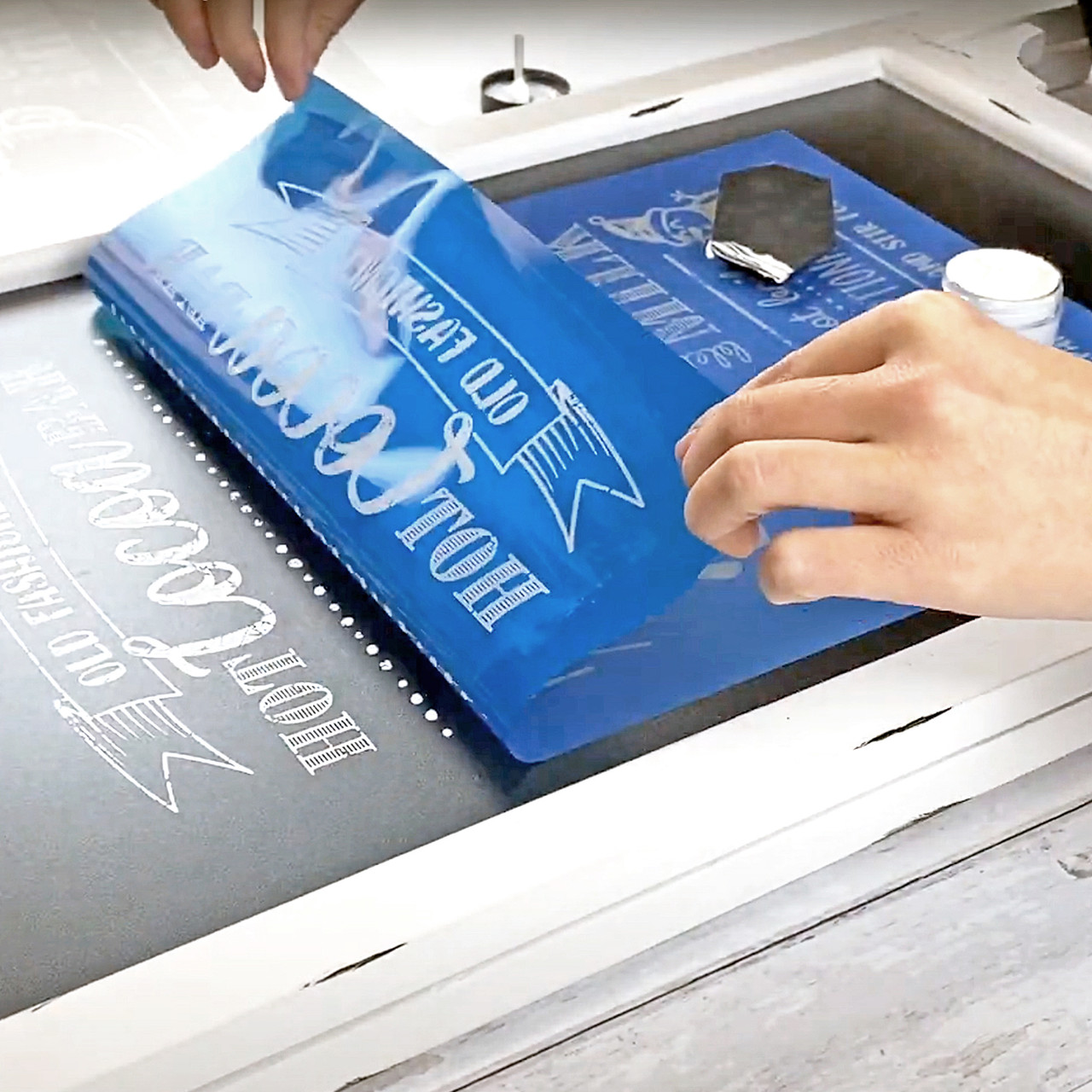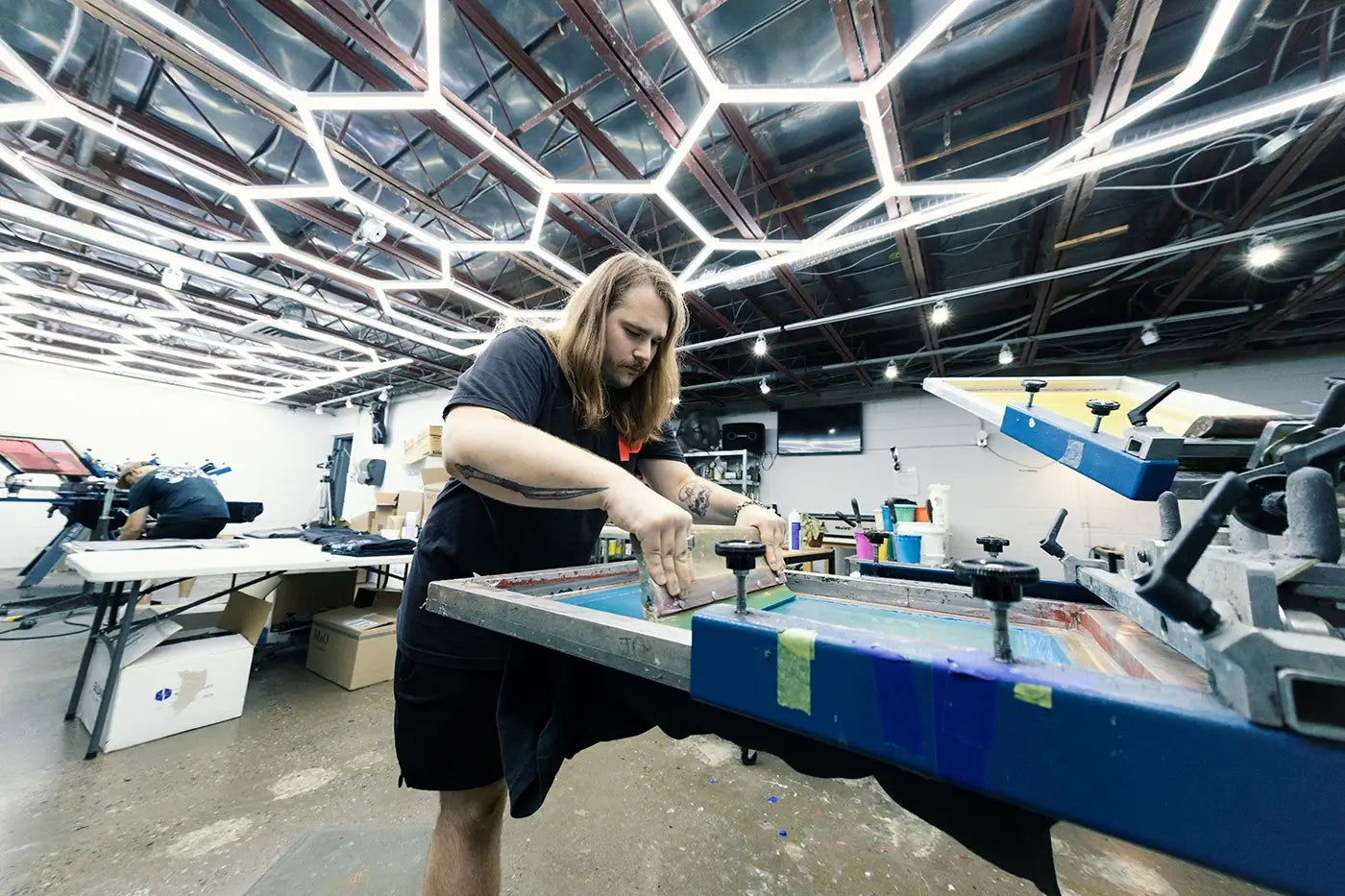Display Printing Uncovered: Every Little Thing You Required to Understand About Tee and Garment Printing Techniques
Screen printing is a fascinating method that integrates art with technique, offering countless possibilities for creativity. Ready to discover the crucial elements that make screen publishing an art kind?
The Essentials of Screen Printing: How It Functions
When you dive into display printing, you'll uncover it's both a science and an art. At its core, screen printing includes producing a stencil, or screen, that permits ink to pass through only in specific locations (screen printing kit). You begin by picking your style and preparing your screen with a light-sensitive solution. Once you subject this solution to light, it hardens, leaving your layout as a negative area.
Setting the display over the fabric, after that make use of a squeegee to press ink through the display onto the garment. Each step is necessary, and mastering them will raise your screen printing skills, transforming straightforward garments into unique, expressive items.
Kinds Of Screen Printing Strategies
As soon as you comprehend the basics of screen printing, it's time to explore the numerous techniques that can raise your layouts. One preferred approach is typical display printing, where ink is pushed through a stenciled display. This technique is wonderful for bold, dynamic colors. There's water-based ink printing, which offers a softer feel and is environmentally friendly, however it needs a different approach to curing.
An additional option is plastisol printing, known for its durability and dazzling shades, making it a favored for numerous brand names. Experiment with halftone printing to produce gradient results and complex designs.
Essential Equipment for Display Printing
To attain spectacular results in screen printing, having the right equipment is fundamental. You'll require a durable screen printing framework, which holds the mesh that transfers your layout onto the garment. Next, spend in high-quality mops; these are crucial for using ink evenly across the screen.
Picking the Right Inks and Materials
When choosing inks and products for screen printing, you require to consider the sort of ink that works finest for your job. Consider fabric compatibility to ensure your styles look great and last long. Likewise, explore eco-friendly ink choices to make your printing procedure more sustainable.
Sorts Of Display Inks
Choosing the ideal display ink is crucial for attaining lively, sturdy prints that satisfy your project's needs. There are numerous kinds of display inks to check out. Specialty inks, such as metal or glow-in-the-dark, can include special effects to your designs.

Textile Compatibility Factors To Consider
Comprehending fabric compatibility is crucial for achieving premium screen prints, especially considering that different materials respond distinctively to different inks. Always check your inks on sample fabric to guarantee they adhere effectively and maintain color stability. Furthermore, maintain in mind that material weight and texture can influence the last end result, so selecting the ideal ink and material combination is vital for your job's success.
Eco-Friendly Ink Options
Environment-friendly inks are coming to be a preferred option for screen printers who wish to reduce their environmental impact while maintaining quality. When picking inks, think about water-based inks, which are much less damaging and much easier to tidy up contrasted to standard solvents. These inks bond well with fabrics, providing vivid outcomes without poisonous chemicals. You may additionally check out eco-solvent inks that use less unpredictable organic compounds (VOCs), making them a safer alternative for both your health and wellness and the world.
Furthermore, look for inks made from renewable energies, such as soy or vegetable-based options. By selecting the ideal inks and products, you'll not only create sensational styles yet also contribute to a much more sustainable printing process. Make the switch, and your prints will certainly mirror your commitment to the environment!
Preparing Your Style for Display Printing

File Format Demands
To ensure your layout looks sharp and vibrant on material, you'll need to pay close focus to file format requirements for screen printing. Make sure your style has a clear history to protect against undesirable white sides on your prints. Keep color modes in mind; CMYK is common for display printing, so transform your RGB develops accordingly.
Color Separation Techniques
Shade separation is a necessary step in preparing your design for screen printing, and grasping it can considerably enhance your print top quality. You'll require to break your design right into private shades, as each color requires a different screen throughout printing. This precision not just ensures accurate color depiction however also streamlines the printing process.
Resolution and Dimension
Achieving the ideal lead to display printing starts with assuring your design has the ideal resolution and dimension. Ideally, your art work should go to the very least 300 DPI (dots per inch) for sharp, clear prints. If you make use of reduced resolution, your end product may look amateur and pixelated.
When it involves size, think about the measurements of your print location. Style your art work to match the final print size, ideally developing it in the actual dimensions you'll be publishing. In this manner, you'll prevent any kind of unanticipated scaling issues.
Constantly check your style in both vector and raster layouts. Vector graphics can be scaled without shedding quality, making them optimal for display printing. Preparing appropriately will ensure your style looks remarkable on every garment!
Step-by-Step Screen Printing Refine
Display printing is a vibrant process that allows you to create lively designs on different surfaces. To start, you'll require a screen, emulsion, and your selected ink. First, prepare your display by cleansing it thoroughly. Next off, use the emulsion evenly and let it dry in a dark location. Once dry, expose your screen to light with your design put on it, which will harden the emulsion where the light hits, creating a stencil - screen printing kit.
Put ink onto the display and use a squeegee to push the ink with the stencil onto the material. Raise the screen carefully and let the print dry. You've effectively display printed your design.
Tips for Successful Screen Printing Projects
While you're diving right into your screen printing projects, keep in mind that preparation is key to success. Start by collecting all your materials-- inks, squeegees, displays, and garments. A a knockout post clean workspace aids prevent undesirable errors, so clean up before you start.
Next, confirm your art work is high-resolution and effectively sized for your garment. Examine your display for correct exposure and tidy it thoroughly to prevent smudges. When mixing your inks, comply with the manufacturer's guidelines to achieve the right uniformity.
During printing, use even stress with your squeegee for constant outcomes. Do not rush; take your time to validate each print meets your standards. After printing, let your garments dry totally before managing or packaging them.
Last but not least, constantly keep an example of your job for future recommendation. In this manner, you can assess your development and improve your methods gradually. Satisfied printing!

Often Asked Inquiries
How much time Does It Take to Establish up a Screen Printing Task?
Establishing up a screen printing task commonly takes about browse around this site half an hour to an hour. You'll prepare the displays, mix inks, and change the press. The moment varies based on complexity and experience, so stay organized!
Can I Print on Different Material Enters Using the Same Technique?
Yes, you can print on various fabric kinds using the very same technique, yet you'll need to readjust your inks and setups. Some materials absorb ink differently, so experimenting assurances the ideal results for each and every product.
What Prevail Blunders to Stay Clear Of in Screen Printing?
When screen printing, prevent usual errors like making use of the wrong ink, ignoring appropriate direct exposure times, or missing pre-press checks. Always examine your setup and maintain clean screens to guarantee quality outcomes each time.
How Can I Properly Clean and Keep My Display Printing Tools?
To effectively tidy and keep your display printing equipment, you must routinely wash screens with appropriate solvents, examine squeegees for wear, and ensure all tools are stored dry and dust-free. Uniformity prevents costly repairs and boosts efficiency.
Is Screen Printing Eco-friendly Contrasted to Other Techniques?
Screen printing can be extra eco friendly than various other approaches, particularly if you use water-based inks and eco-conscious materials. By selecting sustainable materials and techniques, you decrease waste and lessen your influence on the earth.
Display Printing Uncovered: Every Little Thing You Required to Know Concerning Tee and Garment Printing Techniques
At its core, display printing includes creating a pattern, or display, that permits ink to pass via just in certain locations. Position the screen over the material, after that make use of a squeegee to press ink with the screen onto the garment. One preferred method is typical screen printing, where ink is pushed with a stenciled display.When picking inks and products for display printing, you require to take right into account the kind of ink that functions finest for your task.